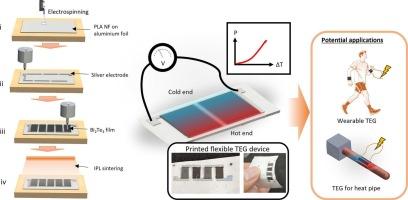气溶胶喷射印刷碲化铋纳米线和强脉冲光烧结柔性热电能量收集装置
IF 7.9
2区 材料科学
Q1 MATERIALS SCIENCE, MULTIDISCIPLINARY
引用次数: 0
摘要
柔性热电装置为可穿戴电子产品、软机器人和可弯曲传感器系统将废能转化为电能提供了巨大的希望。在这项工作中,我们报告了通过气溶胶喷射打印bi2te3基纳米线到PLA纳米纤维基衬底上,然后进行优化的强脉冲光(IPL)烧结,可扩展地制造柔性热电薄膜。我们优化了雾化器,油墨和护套流动,以及打印速度,以确保均匀和精确的图案沉积。光学和扫描电镜分析显示,作为印刷薄膜形成一个交织的,聚集的网络。这种网络不同于在滴铸样品中观察到的排列纳米线。这种差异可能是由高剪切力和气溶胶喷射过程固有的快速溶剂蒸发引起的。在优化的烧结距离和脉冲数下进行IPL烧结,可以有效地致密化薄膜,而不会破坏衬底上的PLA纳米纤维。这些膜形态和致密化的增强对于最小化粒子间电阻和促进有效的载流子传输,最终提高热电性能至关重要。这项研究展示了一种有前途的方法,可以制造高分辨率、灵活的热电设备,适用于利用余热为下一代灵活的物联网(IoT)设备供电。本文章由计算机程序翻译,如有差异,请以英文原文为准。

Flexible thermoelectric energy harvesting devices via aerosol jet printed bismuth telluride (Bi2Te3) nanowires and intense pulsed light sintering
Flexible thermoelectric devices offer great promise in converting waste energy into electrical energy for wearable electronics, soft robotics, and bendable sensor systems. In this work, we report the scalable fabrication of flexible thermoelectric films by aerosol jet printing of Bi2Te3-based nanowires onto a PLA nanofiber-based substrate, followed by optimized intense pulsed light (IPL) sintering. We optimized atomizer, ink, and sheath flows, as well as print speed, to ensure uniform and precise pattern deposition. Optical and SEM analyses revealed that the as-printed films form an intertwined, agglomerated network. This network is distinct from the aligned nanowires observed in drop-cast samples. The difference likely arises from the high shear forces and rapid solvent evaporation inherent to the aerosol jet process. Subsequent IPL sintering, performed at an optimized sintering distance and number of pulses, effectively densified the films without damaging the underlying PLA nanofiber on the substrate. These enhancements in film morphology and densification are crucial for minimizing interparticle resistance and promoting efficient carrier transport, ultimately boosting the thermoelectric performance. This study demonstrates a promising approach for the fabrication of high-resolution, flexible thermoelectric devices suitable for powering next-generation flexible Internet of things (IoT) devices by tapping on waste heat energy.
求助全文
通过发布文献求助,成功后即可免费获取论文全文。
去求助
来源期刊

Materials & Design
Engineering-Mechanical Engineering
CiteScore
14.30
自引率
7.10%
发文量
1028
审稿时长
85 days
期刊介绍:
Materials and Design is a multi-disciplinary journal that publishes original research reports, review articles, and express communications. The journal focuses on studying the structure and properties of inorganic and organic materials, advancements in synthesis, processing, characterization, and testing, the design of materials and engineering systems, and their applications in technology. It aims to bring together various aspects of materials science, engineering, physics, and chemistry.
The journal explores themes ranging from materials to design and aims to reveal the connections between natural and artificial materials, as well as experiment and modeling. Manuscripts submitted to Materials and Design should contain elements of discovery and surprise, as they often contribute new insights into the architecture and function of matter.
 求助内容:
求助内容: 应助结果提醒方式:
应助结果提醒方式:


